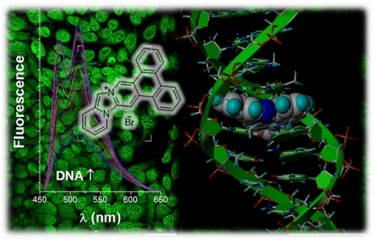https://quibio.web.uah.es/group/
y actualice sus enlaces.
Publicaciones > Bosch et al
Imidazopyridinium cations: A new family of azonia aromatic heterocycles with applications as DNA intercalators.
1. Departamento de Química Inorgánica y Química Orgánica, Química Física e Ingeniería Química, Universidad de Alcalá, 28871, Alcalá de Henares, Madrid, Spain. 2. Departamento de Biología de Sistemas, Química Física e Ingeniería Química, Universidad de Alcalá, 28871, Alcalá de Henares, Madrid, Spain. 3. Departamento de Química Analítica, Química Física e Ingeniería Química, Universidad de Alcalá, 28871, Alcalá de Henares, Madrid, Spain.
Abstract
Two novel imidazopyridinium cations formed by a hexacyclic azonia aromatic system have been synthesized. Spectrofluorimetric titrations, circular dichroism measurements, theoretical simulations and fluorescence-based thermal denaturation experiments on these materials have shown the interesting fluorescence properties and DNA-binding ability by intercalation, with a marked preference for AT-rich sequences. Compound 2 presents the highest fluorescence quantum yield (0.32 in 5% DMSO/water and 0.46 in MeOH) and affinity for DNA (binding constant of ∼4.5 × 105 M−1). Moreover, the potential of these compounds for cell staining has been investigated in living HeLa cells by confocal microscopy imaging. This analysis showed the remarkable capacity of both compounds for uptake and accumulation by living cells.

